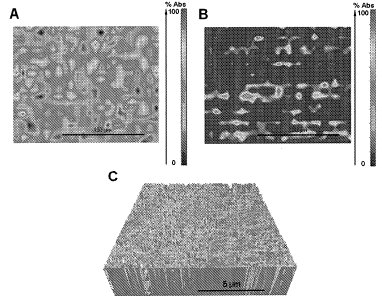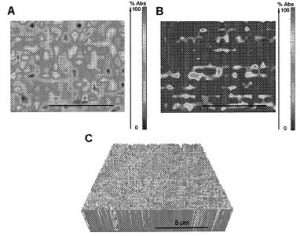Biopuces pour la détection de l'activité enzymatique d'une enzyme protéase
La présente invention concerne une biopuce destinée à la détection de l'activité d'une enzyme protéase comprenant un support avec des sites prédéterminés recouverts d'une couche susceptible d'être obtenue par : – mise en contact des sites prédéterminés avec un premier et un deuxième composé silane, ces composés comprenant respectivement un groupe apte à réagir avec un groupe fonctionnel du support pour former une liaison covalente, un bras espaceur et un groupe terminal. Le bras espaceur du premier composé silane et le bras espaceur du second composé silane sont une chaîne hydrocarbonée comprenant un nombre d'atomes de carbone supérieur à 17, le groupe terminal du premier composé silane est un groupe apte à réagir avec une fonction d'un substrat de l'enzyme protéase pour former une liaison covalente; Le groupe terminal du second composé silane est un groupe non apte à réagir avec une fonction du substrat de l'enzyme protéase, moyennant quoi les sites prédéterminés sont greffés par le premier composé silane et le second composé silane; – mise en contact des sites prédéterminés
Biochips for detecting the enzymatic activity of a protease enzyme
WIPO link
The invention relates to a biochip for detecting the activity of a protease enzyme comprising a support comprising pre-determined sites covered by a layer that can be obtained by: bringing the pre-determined sites into contact with at least one first silane compound and at least one second silane compound, said first silane compound and second silane compound each comprising a group that can react with a functional group of the support in order to form a covalent bond, a spacer arm and an end group, the spacer arm of the first silane compound and the spacer arm of the second silane compound being a hydrocarbonated chain comprising more than 17 carbon atoms, said end group of the first silane compound being a group that can react with a function of a substrate of said protease enzyme in order to form a covalent bond, and said end group of the second silane compound being a group that cannot react with a function of the substrate of said protease enzyme, so that the pre-determined sites are grafted by the first silane compound and the second silane compound; and by bringing the pre-determined sites grafted in this way into contact with the substrate of said protease enzyme, so that the substrate reacts, by means of a side group, with the end group of the first silane compound in order to form a covalent bond.
Contact: T. Berthelot



